History of Gingerbread-makers in Český Krumlov
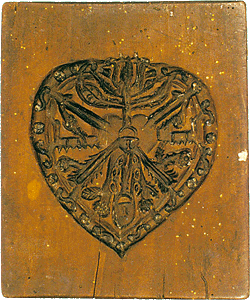 The oldest mention of
gingerbread-makers in Český Krumlov is documented in 1617 when the
local gingerbread-maker Master Jakub Prunner is mentioned. The
meaningful document related to the gingerbread production in this
town is the guild regulation of the bakers' guild to which the
gingerbread makers belonged issued by the princess widow Anna Marie
Branibor von Eggenberg who governed the Český Krumlov dominion on
behalf of her underaged sons. We learn from the guild regulation
that he who wanted to become a Master had to create a so-called
masterpiece which gave evidence of his skills. The
gingerbread-makers were also allowed to sell their products in
Český Krumlov as well as in the whole dominion. They also gained
permission to sell wax and honey. The gingerbread-makers used wax
for making candles which belonged to the assortment of their
goods.
The oldest mention of
gingerbread-makers in Český Krumlov is documented in 1617 when the
local gingerbread-maker Master Jakub Prunner is mentioned. The
meaningful document related to the gingerbread production in this
town is the guild regulation of the bakers' guild to which the
gingerbread makers belonged issued by the princess widow Anna Marie
Branibor von Eggenberg who governed the Český Krumlov dominion on
behalf of her underaged sons. We learn from the guild regulation
that he who wanted to become a Master had to create a so-called
masterpiece which gave evidence of his skills. The
gingerbread-makers were also allowed to sell their products in
Český Krumlov as well as in the whole dominion. They also gained
permission to sell wax and honey. The gingerbread-makers used wax
for making candles which belonged to the assortment of their
goods.

|

|

|

|
In the second half of the 17th century the gingerbread-maker Jiří Sinn is mentioned in 1651 as moving to the town from Austria and the gingerbread-maker Master David Kirschberger who settled here in 1667. The gingerbread-makers sold their goods in Český Krumlov, at fairs and particularly at pilgrimage gatherings. The gingerbread sale was protected by various privileges which ensured a privileged position against competition to the gingerbread-makers of Český Krumlov. In spite of that fact, various contentions of sale priority occurred; for instance at the begining of the 18th century such a conflict broke out between gingerbread-makers from Český Krumlov and České Budějovice who contended the right to sell their products at the Marian Place of Pilgrimage in Kájov.
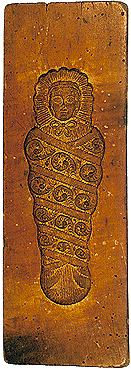 Gingerbread-makers were
in practice in Český Krumlov until the Great War; Josef Petziwal
who bought a gingerbread workshop in the town in 1878 was one of
the last members of this craft. After the Great War confectioners
gradually took hold of gingerbread production and once and for all
this peculiar craft became extinct due to the approach of
industrial gingerbread production and an increasing interest in
other kinds of confectionery.
Gingerbread-makers were
in practice in Český Krumlov until the Great War; Josef Petziwal
who bought a gingerbread workshop in the town in 1878 was one of
the last members of this craft. After the Great War confectioners
gradually took hold of gingerbread production and once and for all
this peculiar craft became extinct due to the approach of
industrial gingerbread production and an increasing interest in
other kinds of confectionery.
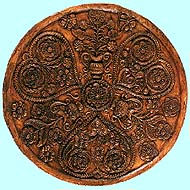
|

|
Old gingerbread moulds and period recipes inform us what gingerbread looked like in the 17th and 18th centuries. In the District Museum of National History in Český Krumlov a large collection of Baroque gingerbread moulds can be found; the two oldest ones are dated earlier than 1645. Gingerbread-makers themselves carved the forms from pear wood. The dough made from honey, rye flour and spices was pressed into the forms sprinkled with pea flour which was to prevent from sticking.
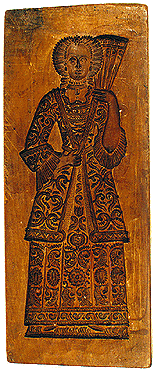
|
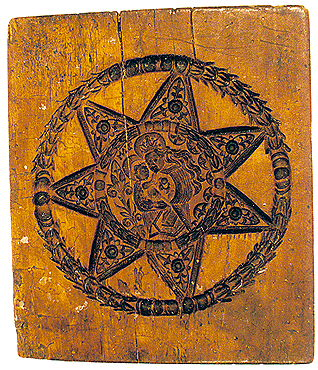
|
The range of mould motifs from Český Krumlov is very rich. Among the most often used topics are an infant in swaddling clothes, heart, soldier, fish, cavalier, lady, flowers and many other figurative and ornamental motifs. An interesting set consists of forms with religious motifs. These are portrayals of the Holy Virgin with the Infant Jesus, saints and church symbols. The gingerbread of such forms was particularly sold at places of pilgrimage. Molds with the fish motif are typical of Český Krumlov. It is said that gingerbread fish started to be made in connection with a legend about a great drought which had distressed the whole district at the beginning of the 17th century until the cloud-burst put it to an end after which water overflew the banks and fish appeared everywhere. It is rumoured that the rain was achieved through the prayers by the inhabitants of Český Krumlov and České Budějovice in the Pilgrimage Church Kájov.

|

|
Ginger-bread was bought as presents for children, it was possible to declare love by means of it and not last the ginger-bread was used for cooking as it was added in various kinds of sauce or it was used to sprinkle gruel with.
 Recipe for Honey
Gingerbread from Český Krumlov:
Recipe for Honey
Gingerbread from Český Krumlov:
300g rye flour
150g sugar
120 g honey
2 eggs
spice (aniseed, clove, cinnamon)
ginger-bread baking powder (normal baking powder)
The dough is treated on a pastry board, sieve the flour and add the other ingredients. Make a rather tough dough and carve out the shapes; bake them on a thoroughly greased baking-sheet. After cooling, decorate the ginger-bread with white icing.
Other information:
History
of Guilds and Crafts in Český Krumlov

